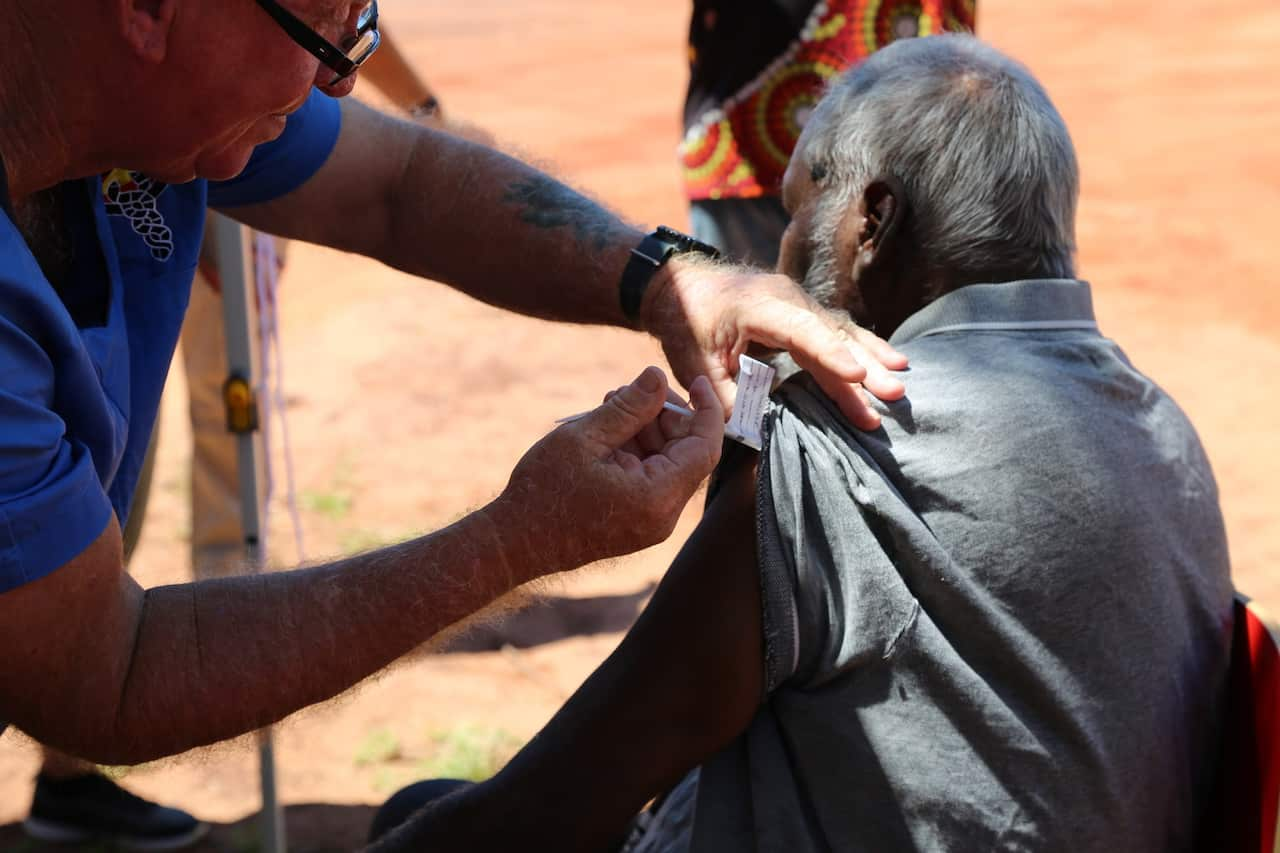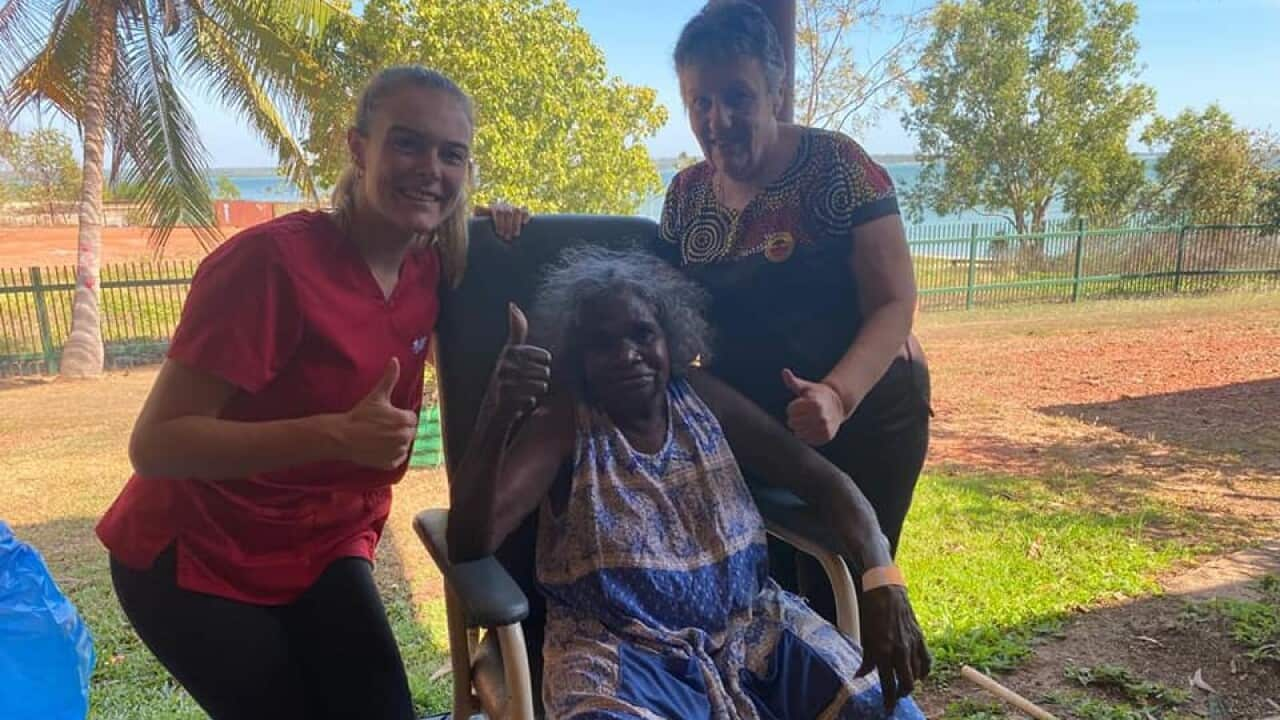A new multidisciplinary network of about 50 experts across health, engineering and law say Australia's current 80 per cent COVID-19 vaccination target for its adult population is "insufficient" for a safe re-opening.
OzSAGE - an alliance of experts inspired by the UK Independent SAGE (Scientific Advisory Group for Emergencies) - met for the first time last month to provide independent advice on strategies to exit the coronavirus pandemic with minimal deaths and severe hospitalisations.
In its in a series of publications to come, the group said the current vaccination target of 80 per cent double dose coverage for Australians aged 16 and above risks leaving many Australians behind.
"Vaccination rates in the community are widely varied, as seen in regional and remote communities affected by the NSW epidemic. We must specify minimum geographic and population sub-group vaccination thresholds for reopening."
OzSAGE member Professor Nancy Baxter said - at the very minimum - the 80 per cent threshold should be lowered from those aged 16-plus to those aged 12-plus, now that adolescents are eligible for vaccination. But of most concern are under-vaccinated pockets of communities, including people from lower socio-economic backgrounds who face more barriers in accessing healthcare.
"You end up getting this triple jeopardy where someone is more at risk, they're more likely to get COVID, and if they get COVID, they are more likely to have serious illness."
"If you don't have 80 per cent of the disabled, or 80 per cent of the Indigenous community [vaccinated], those people who are most at-risk of COVID are going to be the least protected. It's going to result in more illness and death than we have to have.
"So as part of the opening up, these people need to be kept in mind, and it is very important that they're not left behind."
Nationally, 36 per cent of Australian adults are fully vaccinated and 60 per cent have received one dose.
The overall 80 per cent target for adults aged 16-plus is equivalent to 64 per cent of the entire population.
The OzSAGE authors said re-opening at that level of vaccination coverage - without further public health interventions such as improving ventilation - "will turbocharge COVID-19, as seen in countries that lifted restrictions at about 60 per cent whole population vaccination rates".
The report recommends that even upon re-opening, scalable interventions need to be used when necessary, such as a third booster shot, masks, crowd control measures and lockdowns to reduce contact between people.
On Friday, Prime Minister Scott Morrison said the federal government remains committed to the 80 per cent threshold for ending lockdowns.
"It's a plan that will see Australia open up again and move forward again. It doesn't come without risks, and it's important it is done safely, and it is a safe plan with a soft opening as you ease into a more broad opening when we hit 80 per cent."
"It wasn't an all or nothing plan. It was a plan that was very careful based on the best science and economic advice."
Indigenous doctors push for 90-95 per cent vaccination rate
The Australian Indigenous Doctors’ Association (AIDA) has called for a rapid upscaling of the deployment of specialist health teams to regional Indigenous communities around the country to counter vaccine hesitancy and ensure accessibility of supply.
"We have been making some headway, but a gap remains," said Dr Simone Raye, a Bardi Jabbir Jabbir woman and vice-president of AIDA who is a GP based in Darwin. She said she would like to see vaccination rates among Aboriginal and Torres Strait Islanders between 90 and 95 per cent.
She said she would like to see vaccination rates among Aboriginal and Torres Strait Islanders between 90 and 95 per cent.

Dr Simone Raye says there needs to massive upscaling of efforts to boost the vaccination rate for Indigenous Australians to between 90 and 95 per cent. Source: The Australian Indigenous Doctors’ Association
"It is critical that we don't leave anyone behind."
showed Indigenous vaccination rates were under 10 per cent in Indigenous communities in Western Australia.
Dr Raye said the recent death of an Aboriginal man in his fifties in Dubbo, NSW, has other Indigenous communities around the country on alert for the need to boost vaccine rates.
"If we got COVID in the Northern Territory, it would be absolutely devastating. When you look at our hospital health services here and the fact that a lot of our communities are so remote, trying to get health care to them is such a hard problem."
"Then you look at the issues of overcrowding, social inequity and just the general lack of resources in the communities. We just wouldn't be able to cope with it here in the Northern Territory, and certainly across the northern parts of Australia."
Dr Raye said there are success stories of high vaccination rates being achieved in communities, including a track record of childhood vaccination rates of 93 per cent. She said community Elders were also pivotal in the achievements of Aboriginal communities including Maningrida in the NT and Djarindjin in WA attaining 65 per cent and 80 per cent vaccination rates.
"It shows that if we use the right techniques with the communication and consultation, and getting that right story across, that we can improve the vaccination rates." Mr Morrison conceded that under-vaccination in parts of Australia needed to be addressed, but said ultimately the commitment to re-opening at the 80 per cent threshold must remain.
Mr Morrison conceded that under-vaccination in parts of Australia needed to be addressed, but said ultimately the commitment to re-opening at the 80 per cent threshold must remain.

A man receives a coronavirus vaccine in the remote Aboriginal community of Beagle Bay, WA. Source: KIMBERLEY ABORIGINAL MEDICAL SERVICES
"We need to get the vaccination levels in our Indigenous communities as high as possible. But at the same time, it does not disable us from the whole community being able to move forward under the national plan and the national plan appreciates that.
"There needs to be an ongoing plan for dealing with disadvantaged communities post 70 and 80 per cent vaccination because they tend to be the less vaccinated."
He also said the federal government is aware of the need to ensure vaccines reach "the homeless community ... those who have life challenges such as drug use".
Federal Health Minister Greg Hunt said extra health teams and resources have been deployed to regional parts of NSW and Victoria, improving the national rate of vaccinations amongst Indigenous Australians.
At least 37 per cent of First Nations people have had one jab, and 20.5 per cent both.
"Ninety-nine per cent of people living in remote Australia have had access to vaccines," Mr Hunt said.
Listening to voices 'that have historically been ignored'
Dr Kalinda Griffiths, a Yawuru woman and epidemiologist at UNSW, is an OzSAGE member. She said the collaboration of experts is unique.
"It is important those insights are generated. This is about enhancing what has already been done [by government] and I think it is really important for us to get down to some very quite specific nitty-gritty details with this," she said, in terms of the impacts on Indigenous Australians and vulnerable populations.
"When you're working within your government systems, you are often limited by page numbers or the duration of time given." The OzSAGE report said it is important that modelling is developed that "takes into consideration the different age structure and community structures of Aboriginal and Torres Strait Islander Australians".
The OzSAGE report said it is important that modelling is developed that "takes into consideration the different age structure and community structures of Aboriginal and Torres Strait Islander Australians".

Despite the higher health risks, the national Indigenous vaccine rates are sitting well behind the general population. Source: KIMBERLEY ABORIGINAL MEDICAL SERVICES
Dr Griffiths said high-quality subset data would help in the development of a comprehensive education campaign to address vaccine hesitancy among Aboriginal and Torres Strait Islanders, including preparation for the vaccination of children aged 12 and over.
"We need to listen to what is happening on the ground from Elders and frontline workers to ensure we know what is needed so that voices that have historically been ignored are actually put on loudspeaker."
She welcomed this week's release of data on vaccinations for Indigenous Australians but said she will be looking for access to more details.
"It is important that epidemiologists have access to the full picture."
"We were recently able to get hold of state-by-state data ... but now we need to know about the quality of the data.
"Not just the numerator data - the number of vaccines given - but also the denominator data. What population estimates are being used to figure out these rates and proportions?"
Hospitals under strain
NSW is predicted to reach 70 per cent double dose vaccination for those aged 16 and above by the end of October and 80 per cent in mid-November.
COVID-19 cases have exceeded 1,000 for a number of consecutive days, with 1,431 new infections reported on Friday. Authorities say the focus is now on increasing vaccination rates to reduce the number of people needing hospitalisation.
Under the modelling done by OzSAGE, at the earliest date for re-opening on 28 September "there will be an average of 1,437 new cases per day" under the current restrictions and with contact tracing reduced by 20 per cent.
The OzSAGE authors said the need for hospital and ICU beds under different exit scenarios will be presented in a future report. They cautioned that any modelling would need to account for the diminished effectiveness of contact tracing systems in the presence of large case numbers such as 1,000-plus.
"Indications from NSW are that tracing capacity is already exceeded and testing results delayed, which will lead to worse epidemic outcomes."
NSW Premier Gladys Berejiklian has previously said she expects hospital admissions to peak in October. She said on Friday the state government would next week be releasing modelling on the expected hospital admissions for this month and next.
Chief Medical Officer Professor Paul Kelly said state and territory leaders at Friday's national cabinet were presented with "sensitivity analysis" of the Doherty Institute modelling that underpins the plan for re-opening at 80 per cent vaccination levels for the adult population.
He said leaders would be looking at the capacity of hospital systems to withstand more COVID-19 cases and "the other elements that are part of the plan, which is the testing, tracing, isolating and quarantining; and how it may evolve as we learn to live with COVID, as well as the public health and social measures".
The OzSAGE report said vaccination alone cannot lead to a safe easing of COVID-19 restrictions and other interventions are required.
"We must also continue some interventions like masks, vaccinate children, make schools safer, ventilate public venues, and give frontline health workers a third dose booster to protect them and the health system."
"If restrictions are lifted under the current plan, we will likely face a resurgence like those in Israel and the US, with the health workforce and system overwhelmed."












